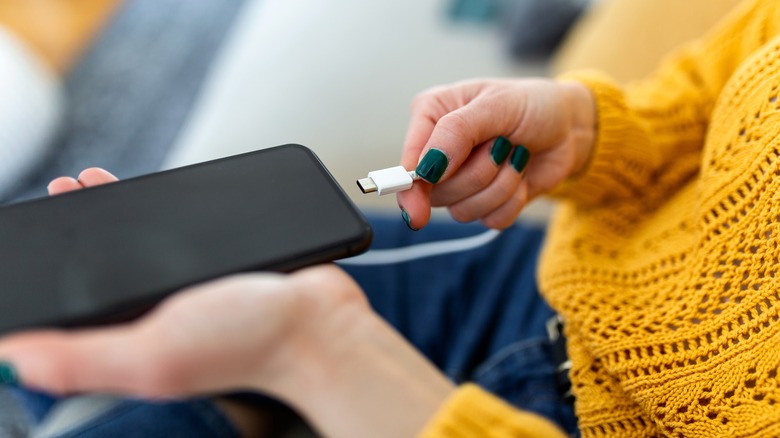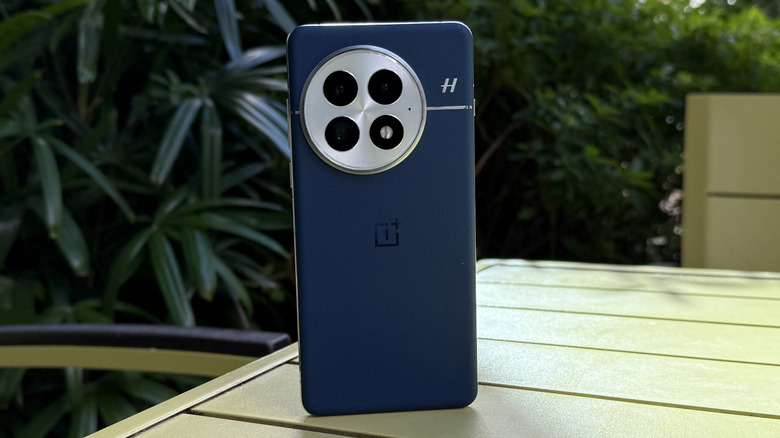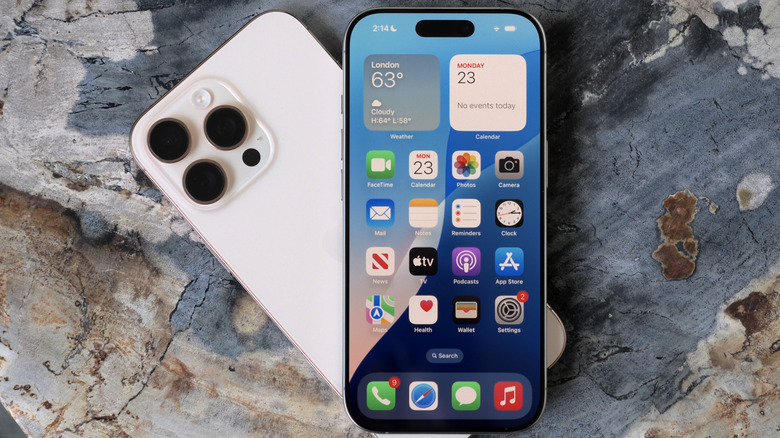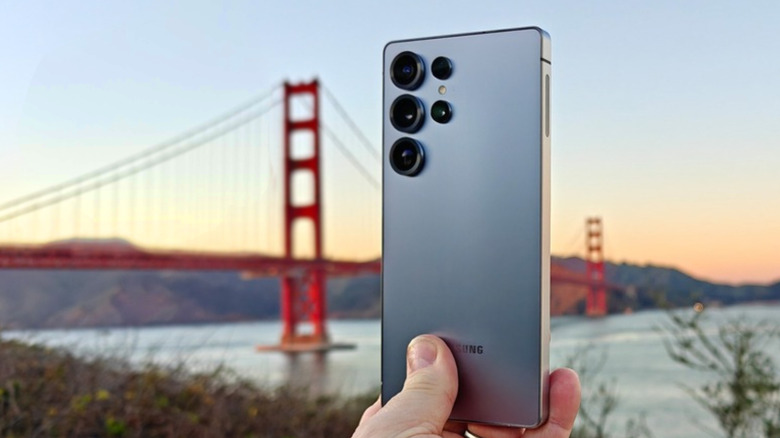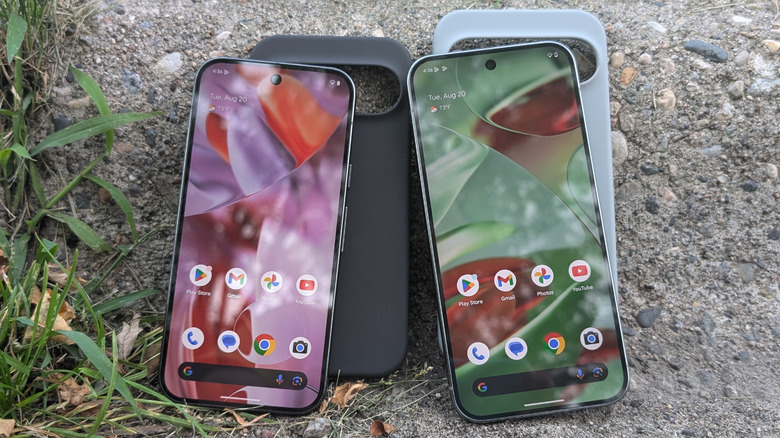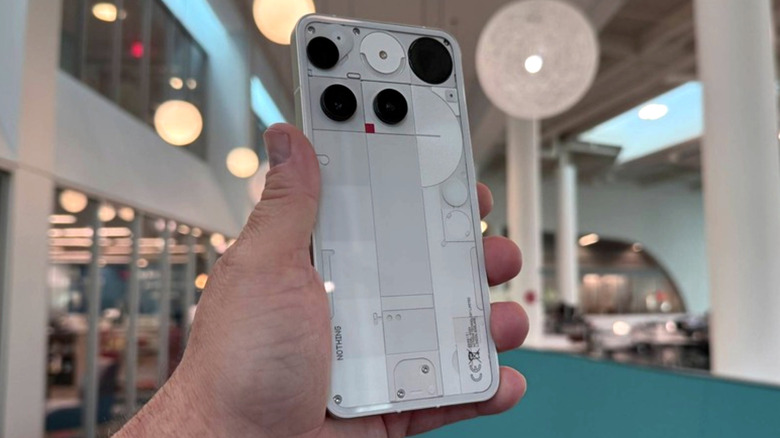5 Smartphones With The Great Battery Life You Can Buy Right Now
We may receive a commission on purchases made from links.
It's been said that we've already reached "peak smartphone"; that is, we've already perfected smartphones, so most improvements from here on out will only be marginal. Battery life is one area, however, where we're waiting for a big breakthrough to change everything. Until new battery technologies revolutionize battery life, smartphones remain stuck in the rut of "all-day" battery life that they've had for years already. You might squeeze an extra few percentage points by changing a few iPhone settings to extend battery life, or you could buy a smartphone that boasts great battery life from the very beginning.
A few important things to note here. First, this is not about the smartphones with the absolute best battery life; Chinese smartphone manufacturers are dominating that category thanks to their use of higher-capacity silicon-carbon batteries, which can't be purchased in the U.S., unlike those on this list. Popular brands in the U.S. (Apple, Google, Samsung) have yet to hop on the silicon-carbon bandwagon.
The phones we discuss here have received praise across reviews for good battery life. In addition to this, we're not taking into consideration how each individual phone ranks beyond its battery, nor are we considering price; these phones may lack in other areas. So if it's just great battery life you need, then these five options will do the job for you.
OnePlus 13
Who actually owns OnePlus is a bit confusing, but it's one of the few Chinese-based manufacturers that U.S. customers can buy directly from. OnePlus used to make flagship phones for budget prices. They still have a budget OnePlus Nord lineup, but nowadays their bread and butter is the OnePlus 13, retailing for $899. Paying flagship prices means you get some truly excellent battery life. While this is obviously due in large part to its 6,000-mAh battery, this is also one of two phones on this list that ship to the U.S. with a silicon-carbide battery, or Silicon "NanoStack" battery in OnePlus's words. Perhaps this is also due to software optimization with OnePlus's OxygenOS, so it'll be interesting to see if OnePlus maintains this lead once its U.S.-centric competitors get on the silicon-carbon train.
We've seen general praise across the industry for its battery life, with people specifically noting it as one of the biggest selling points. Our own Adam Doud gave it a special thumbs up for the battery life, too, especially the insanely fast 80W charging speed. Doud mentions how the phone's battery life is so good that it changes a person's relationship with charging. It lasts so long and charges so fast that charging ceases to take up much mental bandwidth. If your phone dies, you can charge it in 30 minutes, no problem, and continue on with your day.
People make a lot of mistakes with charging lithium batteries, and batteries already cause a constant anxiety about keeping them charged. The OnePlus 13 is one phone that seems to have unshackled itself from that problem. You can purchase the OnePlus 13 here.
iPhone 16 Pro Max
The iPhone 16 Pro Max is the biggest phone Apple makes, so it shouldn't come as a surprise that it has some of the best battery life. The huge 6.9-inch screen leaves plenty of room in the chassis for a 4,685-mAh battery. Smartphone batteries in the 5,000-mAh and above range are common in phones with similar battery life, so we can assume the great battery life comes down to the optimization of iOS and Apple silicon chips. Apple advertises the 16 Pro Max as having 27 hours of max battery life when watching video, and 85 hours when the screen is off while listening to audio. As is typical for Apple, it has some of the slowest charging speeds compared to major Android competitors; getting to 50% battery takes half an hour.
Again, the 16 Pro Max gets special praise for its battery life. We reviewed the iPhone 16 Pro and our Chris Davies gave it a thumbs up for the battery, too. So if you have smaller hands or find the Pro Max too large, you can't go wrong with the non-Pro Max. This is likely due in part to the fact that the 16-series iPhones got a screen-size upgrade, so even the standard iPhone 16 benefits from more battery life.
The improvement to thermal design across the 16 series may help here, too. While a reduction in operating temperature doesn't directly affect battery life, it may help give the battery a longer lifespan. It's well known that heat can hurt your phone's battery. You can get the iPhone 16 Pro Max for a small refurbished discount here.
Samsung Galaxy S25 Ultra
Among Android phones, one could argue (quite easily) that the Samsung Galaxy S25 Ultra is the cream of the crop, the gold standard of Android in just about every way imaginable: excellent cameras, top-of-the-line hardware, and a great screen. Coming as a surprise to no one, it also gets great battery life. Part of this is just sheer size, hence the Ultra moniker; this is another 6.9-inch phone with a 5,000-mAh battery. However, the S25 Ultra is not a significant upgrade over the S24 Ultra. In fact, they both have the same size battery despite the S25 being slightly larger. You'll save yourself a bit of money by grabbing the older version and still get great battery life.
Battery life is one of the big selling points for the S25 Ultra across the board, whoever you ask. Adam Doud noted in his S25 Ultra review how he went two days on a single charge and still had a bit left in the tank. Enough said. For people who aren't heavy phone users, this might well be a two-day battery life phone.
However, the Galaxy S25 Ultra does lag behind a bit in fast charging. It supports up to 45W with a cable, which translates to 65% charge in half an hour. To be fair, this is fast enough for most people, but it does cause the Ultra to fall short of the lightning-fast charging and massive battery life of the OnePlus 13.
Google Pixel 9 Pro XL
Many have dubbed the Google Pixel series of phones the "smartest" smartphones around. No other phone on the market has used AI as extensively as the Pixel lineup has; speaking from personal experience, smart features are so thoroughly integrated that you'll often stumble upon hidden Google Pixel features you didn't know about. It feels like the Pixel team has really thought of everything. As luck would have it, the battery life on the Pixel 9 Pro XL is quite impressive. Hardware-wise, it has a 5,060-mAh battery that offers a respectable 37W wired fast charging. The great battery life could be in great part due to Android's Adaptive Battery optimizations, but perhaps Google's Pixels are doing some extra AI magic under the hood as well.
As you probably guessed, the Pixel 9 Pro XL gets nothing but thumbs up for its battery, although the fanfare is not nearly as loud in that department as it is for other phones on this list. Plus, you may have noticed that we mentioned the Pixel 9 Pro XL, but not the newer Pixel 10 Pro XL. Why, you may ask? Simply: The battery life didn't get a noticeable upgrade.
In fact, some people consider the 10 Pro XL as a whole to be one step forward and two steps back. Namely, U.S. Pixel 10 Pro phones are eSIM only, support Wi-Fi 6e (whereas the 9 supported Wi-Fi 7), and have a downgraded camera sensor. This is one of the few phones on this list where we'd say that, battery-wise, you're better off grabbing the older version. You can purchase the Google Pixel 9 Pro XL here, or the newer Google Pixel 10 Pro XL here.
Nothing Phone 3
Similar to the OnePlus phones, the Nothing Phone was intended as a budget series with flagship specs and unparalleled flair. You'll know it as the phone with the cyberpunk-esque glowing backplate. The Nothing Phone (3) was a departure from the budget paradigm, starting at $799 compared to previous options like the dirt-cheap $279 Nothing CMF Phone 2. Whether or not it was worth that price is up for debate, but in terms of the battery, it seems to have hit the mark.
The reason why is twofold. One, this is a big 5,150-mAh battery with 65W fast charging. Two, it's silicon-carbon. If you've been waiting for OPPO or Vivo to start shipping their phones with never-ending silicon-carbon battery life to the U.S., then at least for now the OnePlus 13 and the Nothing Phone (3) are solid alternatives.
Adam Doud noted in his review that, similar to other phones on this list, it has the sort of battery that one can forget about, likely thanks to its silicon-carbon magic. Others seem to agree that on the battery front, the Nothing Phone (3) gets the job done. As an added bonus, the Nothing Phone (3) supports reverse wired and wireless charging, so you can share that huge battery with other devices. Lastly, it has an idiosyncratic "glyph interface," a small circle on the top right-hand corner of the backplate that displays information — including battery life. So you can set your phone face-down on the table and gauge battery without flipping it over. Buy the Nothing Phone (3) here.
